Welcome to CocoaReworks, a website dedicated to the experiences of women who worked at the Rowntree confectionery factory in York, England.
This website looks at the experiences of just thirteen women, interviewed in June and July 2000 for a thesis at the Centre for Women's Studies, University of York.
Our thanks must go to all the women who have made this project possible.
We hope that we have done justice to their fascinating life stories. When accessing this site please respect their testimony.
Factory History
“A little grocer’s shop opened more than 200 years ago by a woman in defiance of a powerful trade guild formed the foundation of one of the world’s largest chocolate and cocoa manufacturing businesses.” Cocoa Works Magazine, Christmas 1932, p.862.
The story of Rowntrees usually begins with Mary Tuke, a Quaker woman who opened her own grocer's shop, defying the rules of the men-only trade guild. It was this shop which was eventually taken over by Henry Isaac Rowntree, founder of the first Rowntree factory at Tanner's Moat in 1864.
From these early days, women as young as thirteen were employed at the factory. A 'lady welfare supervisor' was appointed in 1891 to look after female workers. Women and girls worked mostly on decorating, sorting and packing the confectionery.
The most successful product of early years was Fruit Pastilles; and it was not until the 1930s that the now famous chocolate products of Black Magic , Kit Kat , Smarties and Aero
were developed. As the business took off, employment opportunities for women increased, although married women still weren't allowed to become permanent workers and could only get work as seasonal staff.
During the Second World War many women were taken off their work with confectionery to produce munitions. However, the demand for confectionery was high after the war and Rowntrees experienced a shortage of female labour in the 1950s and 60s. To make up the shortfall, married women and women from outside York were actively recruited.
Rowntree merged with Mackintosh to become Rowntree Mackintosh in 1969, although this did not seem to bring major changes according to most women. However, in 1988, the company was the victim of a dramatic take-over by the Swiss firm Nestlé, despite strong local protest.
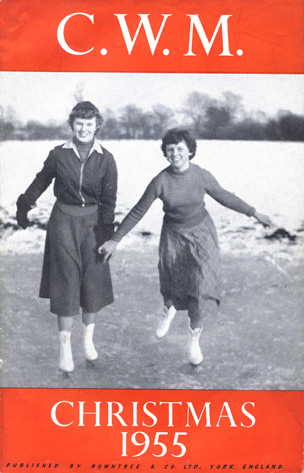
The front cover of the Christmas 1955 issue of the Cocoa Works magazine

First Days
"I was leaving, first day I started — never seen so many people in my life" (Jean)
Starting work at Rowntrees could be difficult. As Mavis recalls in the sound clip, the sheer size and noise of the factory was a shock. Although there were Teachers
helping new workers to learn their tasks, many of the women recalled their training as simply a matter of “getting on with it.” Training for most was sitting next to another woman doing the same job.
Women who started work at different ages had different experiences, as Alice remembers: “Well we had to start at 38 and do the same rate…without the help.” The conveyor belts were constantly moving, and women had to work to the speed set by the machine. Younger workers were allowed time to develop their speed before being put with more experienced workers. However, for those starting at the factory later in life, no such allowances were made and adjusting to the speed of work was more difficult. Lily, who first went to Rowntrees in her forties, said, “I used to look at the people opposite me and think…I’ll never be like that.”
A Teacher helping new staff learn their tasks
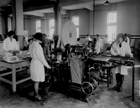
Working on the Lines
"You used to put one sweet in all day, all day, all day — in a certain compartment in the vacuum formed trays — and that was all they did, you know, just put the one sweet in, one sweet in all the time and it, er — which is still — I don't think anybody was really unhappy there — at least I wasn't, no, no…
" (Alice)
While men mixed the chocolate and moved products around the factory, women worked mainly on the conveyors. As Lily remembered their work included enrobing (covering the sweets with chocolate), piping
patterns onto individual chocolates, and packing these chocolates into the chocolate boxes. Other women would be serving
the line with sweets, by bringing over full trays of chocolates, then taking off the empty trays.
Work changed over the years – before the 1950s an individual woman might be responsible for packing whole boxes of chocolates, putting sweets into individual cups and then into the box according to a set pattern. Later, individual cups were replaced by vacuum formed trays (VFT). Women sat directly at the conveyor, placing only a couple of sweets into the trays as they went past.
The waste room, where women stripped waste sweets of their wrappers, was more relaxed and was often occupied by older workers. Most women worked on several different jobs and they had to adapt to being moved around.
Working on the production lines at Rowntree's

Workers packing chocolates
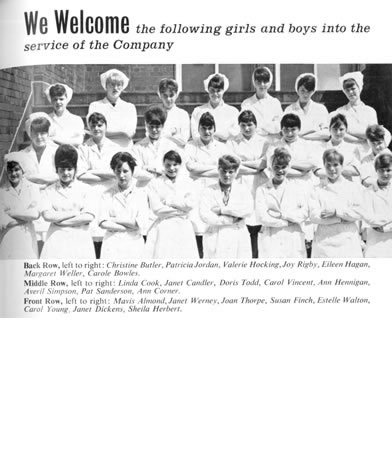
Rules
“You had to obey the rules” (Amy)
On starting work at Rowntrees, women were given a copy of the Works Rules and Regulations. Rules were important in maintaining an environment suitable for the production of food. However, they also aimed to enforce what was seen as appropriate behaviour for women workers and to encourage maximum production.
Women on the shopfloor had to wear an overall and cap (or turban) to work. It was not until 1953 that the same rules were applied to men. Most women accepted the need for wearing a uniform and for high standards of cleanliness. They remembered having to make sure they didn’t have any pins in their clothes, in case these fell into the chocolates. However, women could also bend the rules. Photographs from the Cocoa Works Magazine
show how women (particularly young girls) continued to follow the fashions of the day with beehive hairstyles scarcely covered by the regulation headscarves.
Unlike many factories, women could take short toilet breaks between the regulated rest periods and many used this to their advantage, as Lillian remembers, “sometimes it was just a break you know.”
An archive photo of new starters at the factory
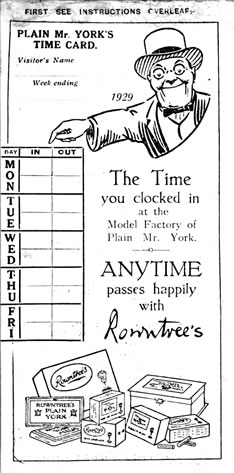
A 'clocking-in card' for factory visitors
Enjoying It
“
But
I enjoyed the years working — I enjoyed the women and the singing and the outings — and I enjoyed the work" (Gladys)
Women had many reasons for enjoying their work at Rowntrees. Sometimes it was simply because they were able to do it or were “used to it.” For instance, Alice remembered how she loved ‘cupping,’ putting the Black Magic sweets into separate paper cups, because she could “just…do them very quick.”
Many women, including Lily, also enjoyed the artistic side of the work – hand-piping
patterns on the chocolates and packing them into beautifully designed boxes. Lily remembers, “it was a lovely presentation with hand-piping to what it is now with the machines.” Box-making, particularly in the days before 'flat-pack' boxes, was another area in which the women could be creative.
Showcases in the factory displayed some of the more prized boxes as a reminder of the company’s significance and success. Jean remembers “you couldn’t beat what we did…they were superb…but they went to royalty.” Women were proud of the high quality work they produced and, as Mavis suggests, this made the job more satisfying. However, most felt that, with more and more machinery being introduced over the years, the quality of Rowntrees products deteriorated.
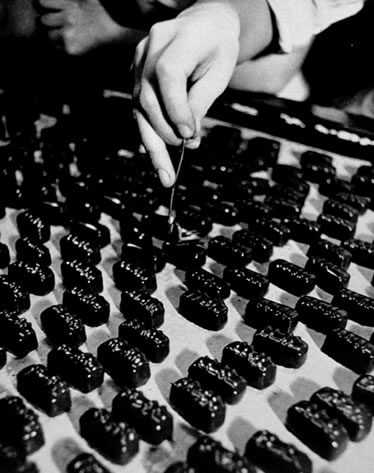
Marking chocolates by hand
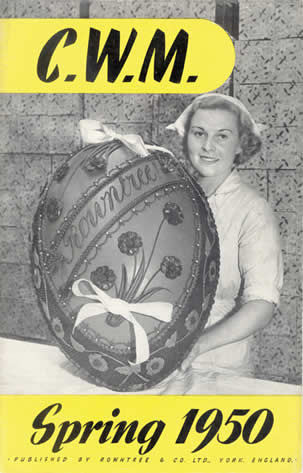

Music While You Work
"they hear us all singing cheerfully at our work. You know the kind of song — 'My gal's a Yorkshire gal'…with its kind words to the 'factory lass.'" Madge Munro, Cocoa Works Magazine, Christmas 1932
In a 1932 radio broadcast, Madge Munro remembered 500 women singing in unison in her room. Singing was seen as a sign of a happy workforce and provided a rhythm to work by. For many singing was “part of liking it”, something which helped them enjoy their work. Allowing workers to sing was also part of Rowntrees’ self-image as a good firm.
During World War II ‘Music While You Work’ — playing records over speakers in the workrooms — was introduced. In the 1940s favourite songs included ‘Pal of my Cradle Days’ and ‘My Gal’s a Yorkshire Gal’ and in the 60s popular music like Cliff Richard and The Beatles was preferred.
In wartime music was seen as a way of raising morale but it was later stopped by some Overlookers, who felt it was distracting. For the workers, however, popular music at work provided an opportunity to wave at sweethearts.
Madge Munro
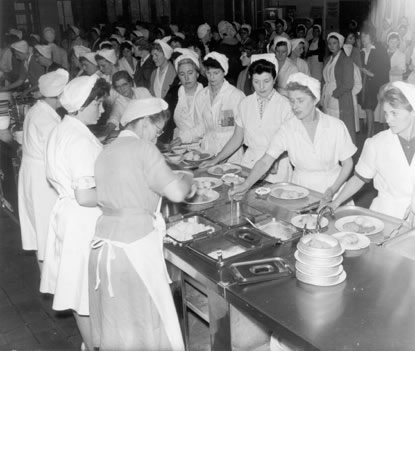
Have a Break
"We all had our own blick in numbers so we all used to meet together to blick our numbers in" (Audrey)
Working hours varied. Some women, particularly single women, worked full time from 7.30am to 5pm. Others worked either mornings or afternoons, or, in later years, an early evening shift. Time keeping was strict and women had to blick in when they started work. It was often difficult to keep to these times due to the demands of childcare or looking after relatives, or perhaps as a result of personal ill health. Edna remembers being repeatedly late for work when her mother was ill. Still, some women did manage to win the Blue Riband award for perfect time keeping.
In the morning there was a 10 minute break, when workers could have a drink and a snack. There was not enough time to go to the canteen, so they would draw their stools away from the conveyors and sit in the work rooms. At lunch those living nearby could go home. Amy remembers taking friends to her mother’s house in New Earswick. Others would go to the works canteen. For many years there was a separate canteen for men and women and another for senior staff.
An archive photo of the factory canteen

Friendship
“I didn’t think I’d last a week there with the different types of girls which you had to cope with in a factory but, then, I was one of ‘em at finish!” (Gladys)
‘Factory girls’ were often seen as mouthy, loud and rude. Although for some women like Lillian, experiencing factory talk came as a shock at first, lasting friendships were quickly made. As Jean remembers, “It just…bred camaraderie really…”
Rowntree's encouraged these friendships, as long as they did not interfere with work, and women were allowed to talk and even sing. ‘Having a laugh’ gave women a break from the factory routine and practical jokes were often played. Though many of the women remembered playing practical jokes on their colleagues they refused to give details for fear of reprisals!
For those who were not on the lines, perhaps as room examiners or checkweighers, the isolation from other women could prove difficult. In the sound clip Audrey explains how as a room examiner she sometimes felt left out by not knowing the latest gossip. Amy refused promotion to the role of Overseer because she preferred to work as part of a team, “I didn’t want to be bossing people about…I liked working with the girls as a group, not as one individual.”
The front cover of the Christmas 1955 issue of the Cocoa Works magazine
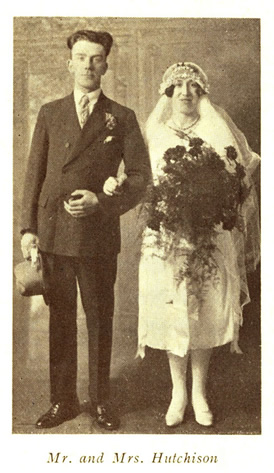
Romance and Celebrations
"I had a really good start to me bottom drawer
" (Mavis)
Many women got married while working at Rowntrees. These celebrations provided a welcome break from the factory routine.
Certain “privileges” were offered to the bride-to-be such as being able to entertain workmates. Friends would bring presents and enjoy cake and tea but, as Mavis recalls, practical jokes were also played: “they would do something to you, or to your coat or whatever…They tied me up and they put all balloons on me coat…”
Despite needing to employ married women, Rowntrees officially promoted a domestic ideal of ‘good’ housewives and mothers. The conflict between staying at home and wanting to work was reflected in many women’s lives. As Amy remembers “I said I was going to finish Rowntrees when I married but I didn’t. I went back to buy two bikes and I was there 46 years after that.”
Mr & Mrs Hutchison, former factory workers
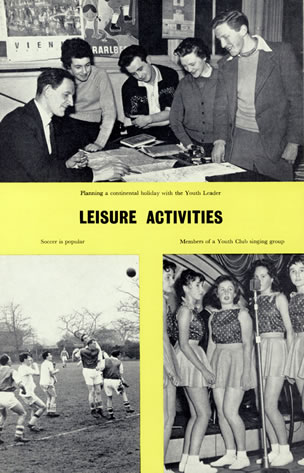
Clubs and After Work
“They’ve always been big on t’social side” (Jean)
Rowntrees organised a variety of clubs and after-work activities for its employees. These ranged from youth clubs, to theatre groups and woodwork classes.
However, most of these activities were simply not designed with working mothers, wives or single carers in mind. Whilst some remember playing sports such as netball as a single girl, the activities, Margaret recalls, “sort of went out of the window” upon marriage and having a family. Films shown at lunchtimes, dances and day trips organised by departments were more popular, as Audrey describes in the sound clip.
After retirement, many women joined in Rowntree-organised activities whilst they remained in good health. As Alice remembers, “When we finished work they started all these things, you know, where you could go to icing classes, dancing classes...” Women receiving a Rowntree pension automatically became members of the Pensioners Club, helping them to keep in touch with former work mates and keeping them up-to-date with activities on offer.
Leisure activities as depicted in a Rowntree publication

...but it's all changed now
“Rowntree is York, or was York” (Jean)
Many of the women remembered their time at Rowntrees with pleasure. Margaret, who lived nearby, spoke of “a lifetime of memories…at that side of town… Rowntrees has been the beginning of my life, all my working life, practically, and the end…” For Jean, Rowntrees was “a mainstay of the city” which “held everything together.”
However, happy memories were often tinged with a sense of loss. In the wake of the move to a mechanised assembly line, many women felt the job had become less skilled, producing chocolates of lower quality.
In 1989 Rowntrees was taken over by Swiss firm, Nestlé. For the women, the take-over reflected the way things had changed since their retirement. Many showed regret about the changes, feeling that it will “all be different now,” and expressing concern over the resulting job losses.
Despite this some women still had connections to the factory. The ‘waste card’ was often used to purchase cheap confectionery and a few women were also in receipt of a regular Christmas card and £10 voucher from the firm. This continuing link to the factory was highly valued and seen as both a privilege and an entitlement.
Rowntree Macintosh products from 1969
Born in 1913, Alice lost her husband and so was a single parent working to support herself and her son. She worked full time at the factory between 1951 and 1975.
Amy went to Rowntrees straight from school. She worked at the factory almost continuously from 1941 to 1987, both full and part time.
Audrey worked at Rowntrees several times between 1948 and 1984. She spent many years as a married woman on the evening shift. She was a checkweigher and had to weigh women’s work to make sure they had packed the right number of sweets.
Born in 1917, Betty worked at the factory as a single woman for 6 months in 1939. During the Second World War she worked at a factory making telescope lenses.
Brenda worked at the factory as a single girl from 1946 to 1950, when she left to get married.
C.G. worked at the factory at various times between 1938 and 1965. She also worked at the Cravens factory.
Edna worked at the factory for over forty years, from 1946 to 1989. She worked full time hours.
Gladys started work at Rowntrees in 1950 when her daughter needed money for grammar school. She worked there until she retired in 1975.
After working as a shop assistant, Jean decided to start work at Rowntrees in 1956. She worked in the cardbox department for many years, until she retired in 1987.
Born in 1912, Lillian worked at Terry’s before getting married and later worked at Rowntrees to pay for medicine for her husband who was a diabetic. She worked there off and on for many years between 1936 and 1975.
Lily started work at Rowntrees in 1956 as a married woman working part time. She worked hand-piping designs onto Black Magic chocolates.
Mavis went to Rowntrees straight from school in 1954 and worked there until she was married in 1959. She also worked there twice during the 1960s. The latter part of her working life was spent at the Retreat.
Margaret started Rowntrees from school in 1939. However, during the Second World War she worked at an aircraft factory as a riveter. She returned to Rowntrees several times. She is the sister of Amy and many other members of her family also worked for Rowntrees. She grew up in a Rowntree-owned house close to the factory.
About the Project: The project began as a university thesis in the Centre for Women’s Studies, University of York, UK but through this website we hope to interest both people who worked at Rowntrees and those who have only come into contact with the firm through its famous products such as Kit Kat and After Eights.
Credits: First we would like to thank Awards for All for providing the funding to make this project possible. Thanks also to Sara Maultby, York Museum’s Trust and the Borthwick Institute for helping us to find and for loaning us material for the site. Most of all, however, our thanks goes to all the women who have made this project possible - we hope that we have done justice to your fascinating life stories and that you enjoy the site. CocoaReworks was designed, written and co-ordinated by Helen Graham, Emma Robertson and Michael Terwey. Helen Graham is a final year PhD student in the Centre for Women's Studies, University of York working on histories, memories and imaginings of the second wave British women's movement.Emma Robertson is currently finishing a PhD on women and the chocolate industry in York and Nigeria in the Department of History, University of York. This project is based on her MA dissertation completed at the Centre for Women's Studies, University of York. Michael Terwey is Assistant Keeper of History at Tyne & Wear Museums. His work involves communicating aspects of Tyneside's past to the public.
